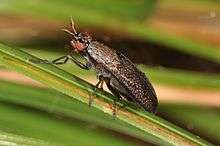Sciomyzidae
| Sciomyzidae | |
|---|---|
 | |
| Imago of unidentified species, Brseč (Croatia) | |
| Scientific classification | |
| Kingdom: | Animalia |
| Phylum: | Arthropoda |
| Class: | Insecta |
| Order: | Diptera |
| Suborder: | Brachycera |
| Subsection: | Acalyptratae |
| Superfamily: | Sciomyzoidea |
| Family: | Sciomyzidae |
| Subfamilies | |
|
Huttonininae (disputed) | |
| Synonyms | |
|
Huttoninidae (disputed) | |
The family Sciomyzidae belongs to the typical flies (Brachycera) of the order Diptera. They are commonly called marsh flies, and in some cases snail-killing flies due to the food of their larvae.
Here, the Huttoninidae, Phaeomyiidae and Tetanoceridae are provisionally included in the Sciomyzidae. Particularly the latter seem to be an unequivocal part of this group and are ranked as tribe of subfamily Sciomyzinae by most modern authors, while the former two are very small lineages that may or may not stand outside the family and are provisionally ranked as subfamilies here. Whether the Salticellinae and the group around Sepedon warrant recognition as additional subfamilies or are better included in the Sciomyzinae proper is likewise not yet entirely clear. Altogether, the main point of contention is the relationship between the "Huttoninidae", "Phaeomyiidae", Sciomyzidae sensu stricto, and the Helosciomyzidae which were also once included in the Sciomyzidae.
Sciomyzidae are found in all the Ecozones but are poorly represented in the Australasian and Oceanian Regions.
Description
For terms see Morphology of Diptera. Sciomyzidae are small or medium-sized (2–14 mm), usually slender flies with predominantly dull grey, brown, reddish or yellow body, rarely black-lustrous. Wings hyaline, often with dark spots or dark reticulate pattern. The head is semispherical or round. The antennae are usually elongate and the arista is pubescent or has shorter or longer hairs. Ocelli and ocellar bristles are present (absent in Sepedon). The postvertical bristles are divergent or parallel. There are one or two pairs of frontal bristles which curve backward (the lower pair sometimes curving inward) Interfrontal bristles are absent but interfrontal setulae are sometimes present. Vibrissae are absent. The wing is clear or with conspicuous markings. The costa is continuous and the subcosta is complete. Crossvein BM-Cu is present and the anal cell (cell cup) is closed. Tibiae almost always have a dorsal preapical bristle.
Biology
Marsh flies are common along the edges of ponds and rivers, and in marshy areas. The adults drink dew and nectar. The larvae prey on or become parasites of gastropods (slugs and snails). The occasional sciomyzid attacks snail eggs or fingernail clams.[1] Very little is known about the complete life cycle of these flies but most of the known larvae are semi-aquatic and some are aquatic. Other species have terrestrial larvae. Larvae mainly prey on non-operculate snails. Some species which prey on bivalves have larvae adapted to breathing under water. In some terrestrial species the penultimate larval instar emerges from the snail or slug it developed in. The last instar is then predatory on several snails.
The adults rest on vegetation head down. According to the larval habitat, they are found near water, in marshy vegetation,in woodland or occasionally dry open habitats.
Identification
- Shtakel'berg, A.A. Family Sciomyzidae in Bei-Bienko, G. Ya, 1988 Keys to the insects of the European Part of the USSR Volume 5 (Diptera) Part 2 English edition.Keys to Palaearctic species but now needs revision .
- Séguy, E. (1934) Diptères: Brachycères. II. Muscidae acalypterae, Scatophagidae. Paris: Éditions Faune de France 28. virtuelle numérique
Selected genera
|
Subfamily Sciomyzinae (possibly polyphyletic)
|
Subfamily Huttonininae (tentatively placed here)
Subfamily Phaeomyiinae (tentatively placed here)
Subfamily Salticellinae (sometimes included in Sciomyzinae)
|
Species Lists
References
- ↑ Foote, B.A.; Knutson, L.V.; Keiper, J.B. (1999). "The snail-killing flies of Alaska (Diptera: Sciomyzidae)". Insecta Mundi. Center for Systematic Entomology, Gainesville, Florida. 13 (1–2): 45–71. Retrieved 31 December 2014.
- ↑ Cresson, E. T., Jr. (1920). "A Revision of the Nearctic Sciomyzidae (Diptera, Acalyptratae)". Transactions of the American Entomological Society. The American Entomological Society. 46: 27–89.
Further reading
- Rozkošný, R., 1984 The Sciomyzidae (Diptera) of Fennoscandia and Denmark. Fauna Entomologica Scandinavica, 14 ISBN 90-04-07592-5 Hardback (224 pp., 639 figures, in English)
- Lloyd Vernon Knutson and Jean-Claude Vala, 2011Biology of Snail-Killing Sciomyzidae Flies Cambridge University Press ISBN 9780521867856
External links
| Wikimedia Commons has media related to Sciomyzidae. |